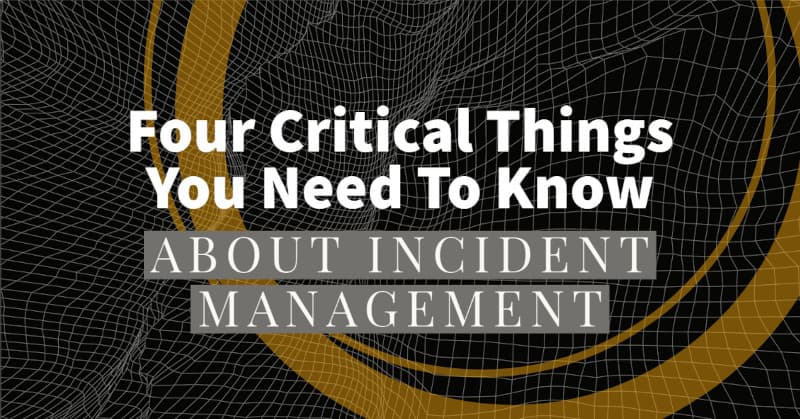16th June 2021
 What caused the Titanic to sink?
What caused the Titanic to sink?
Most people would say the iceberg. Fair enough, she was rather large and kind of put a hole in the ship.
But the reality was, a series of events - small mistakes, oversights - all contributed to the moment that the ship crashed into the iceberg, and Jack sank into the watery depths of the Atlantic. The lack of risk and incident management, appropriate planning, and adequate resources all contributed to the inevitable outcome: total disaster.
Incident management centres around identifying incidents, logging them, understanding exactly what happened and learning from them. Incident management is a life cycle process that feeds into itself. Historic incidents provide valuable learning that can be applied to future systems and protocols.
Streamlining your incident management process is the key to incident reduction and critical to keeping your people safe. Defining the roles each person holds, the channels of communication and establishing how things are done makes for a stronger safety culture.
These four elements of incident management are all critical pieces of the health and safety puzzle. Reviewing how you approach incident management within your organisation helps keep you prepared, resilient and informed about best practice. Here’s a quick refresher about key parts of incident management. Strip away the industry jargon, and remember the critical components of incident management. Stick to the basics, and keep your people at the heart of what you do.
-
1. Understand the difference between an incident and a problem
Incidents are singular, localised independent events that occur as a one-off. Problems, however similar the etymology seems, are ongoing causes of (often) multiple incidents.
Frequent repetitions of common incidents are indicators of a larger problem at hand. One flat tyre is an isolated incident, affecting one truck driver’s day. A series of flat tyres indicates issues with the tyres themselves, or perhaps supply problems that need to be addressed.
Problems are often compounding issues within the main business infrastructure. Fixing problems often requires extensive problem management where the leader takes charge of the bigger picture, classifying the issue correctly and succinctly.
Incidents can occur in surprising ways and encompass a wide variety of things, from security breaches, site outages, physical injuries and more. When incident patterns emerge, you have a problem on your hands, requiring adept problem management - scoping out the wider picture - to solve.
-
2. You have a legal obligation to report incidents
The NZ 2015 Health and Safety Act, as we all know, requires businesses to legally report all incidents, and holds them liable to any crises that may occur. The act aims to provide a greater layer of protection for employees and help incentivise businesses to keep their workers safe.
The act enforces responsibility from all parties: workers are responsible for their own health and wellbeing, while employers need to ensure the workplace is safe and tasks are reasonable.
Should an incident occur, businesses have an obligation to report the more serious incidents to Worksafe - including a death, a notifiable injury or illness, or a notifiable incident. If you’re unsure about what constitutes a serious event, Worksafe’s event tool is a useful resource.
Each New Zealand business needs to put the systems infrastructure in place to mitigate and reduce the potential for serious events to occur in the first place.
-
3. Incident reports are a powerful tool
Incident reports are goldmines of valuable data that can transform business practice and provide the rationale for business decisions moving forward, following the resolution of an incident. Finding a system to analyse the data collected and notice important trends (i.e. annual trends, or seasonal increases in injuries) can help in making an informed and potentially preventative decision.
Reports also hold all the details from key witnesses, where you can examine different perspectives of the events that led up to the incident, and decide where you may make important changes.
In short, incident reporting is a cornerstone for a strong safety culture. When done right, incident reporting reaps the benefits of inspiring a sense of collective urgency, encouraging company-wide improvement, and ensures immediate reinforcement of the critical actions needed following the incident.
All incidents - from serious events, to ‘near-miss’ events - should be reported.
-
4. Communication is key
Connect the right parties with the right information. Make sure people know what’s happened, and how it’s being resolved effectively.
Before an incident, review your company-wide communication procedures and ensure you have an alert system in place that notifies all employees of any immediate incidents or threats. Write out a formal plan that contains all employees’ phone numbers, and establish contacts for after-hours emergencies.
Communication during an incident can be broken down into three key steps:
- - First contact - immediate contact to all relevant parties that an incident has occurred.
- - Regular updates to all stakeholders - throughout the investigative process, and the following days keeping the relevant parties informed is critical, ensuring everyone is clear about the situation’s status.
- - Post-mortem contact - following incident resolution, this is either a meeting or formal communication where the relevant parties can clearly discuss the incident
When talking to employees about safety, remember to keep the conversation as a two-way channel of communication. After all, Safety Differently Leader & Consultant, Moni Hogg put it well in her contribution to the One Percent Safer campaign, noting how those at the front-line know their work the best. People doing the task at hand are the experts. Use their input to reevaluate company-wide practices and systems to apply critical improvements following any incident.
Final Words:
Health and safety professionals in New Zealand are no strangers to the ins and outs of incident management, although a lot of the jargon used to describe protocols and procedures can become daunting.
Remembering what’s important is critical when enacting any step in the process of reporting an incident. Instead of getting lost in the dos and don’ts, taking a step back, examining the bigger picture, and evaluating how incidents can be prevented is essential.
Incident management is not a process designed to cause a headache - rather, it’s the necessary procedure to help save lives, and avoid any future Titanic disasters, before the iceberg is in sight.
- Want to know more about how to create a better health and safety culture? View ecoPortal smarter safety videos. ecoPortal health and safety software can also help your business. Try a demo or get in touch with the team at ecoPortal.







